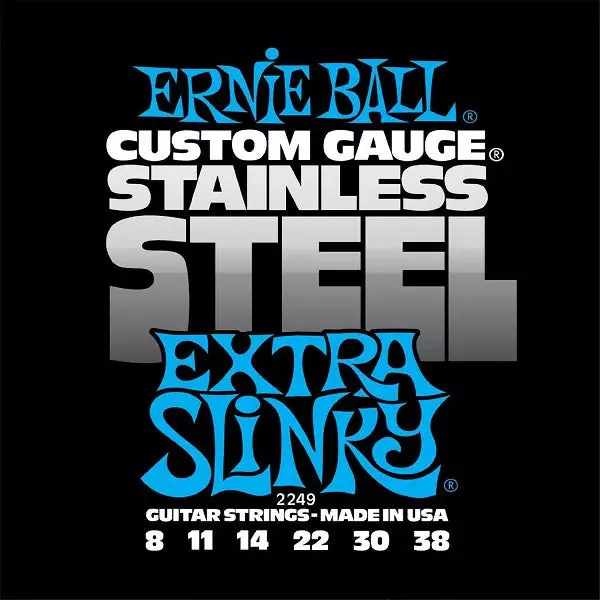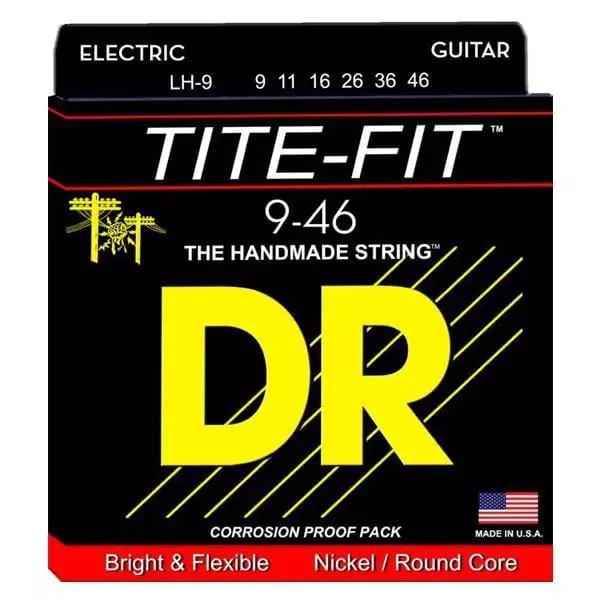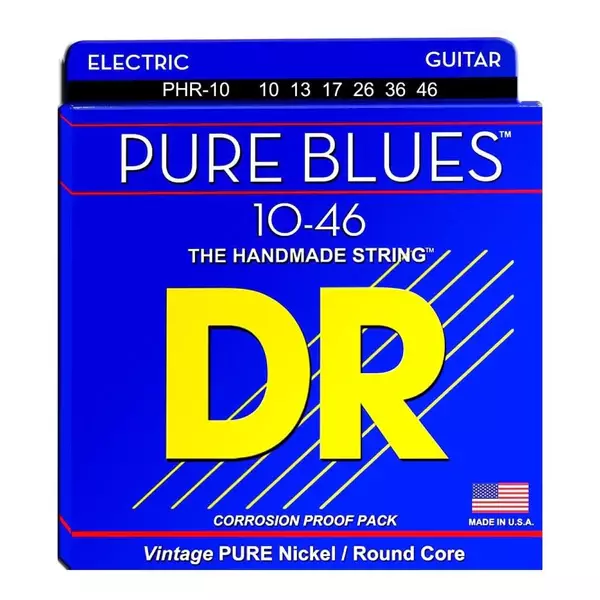How to Choose the Right Strings for Your Guitar: A Complete Guide

Introduction
Most guitarists obsess over amps, pedals, and pickups—but often overlook one of the most influential components of their tone and playing experience: the strings. Strings are not just a medium for producing sound; they are a critical link between your fingers and your gear. Whether you're a blues player chasing warmth or a metal shredder needing precision, the right set of electric guitar strings can dramatically elevate your sound, playing comfort, and even the lifespan of your gear.
Understand String Gauges
What Is String Gauge?
String gauge refers to the thickness or diameter of a guitar string, measured in thousandths of an inch. When you see terms like .009 or .010, they denote the thickness of the high E string in a set. The full set is typically expressed as a range—such as .009–.042—with the smallest and largest string diameters indicated.
Though the difference between gauges may seem minor on paper, even a thousandth of an inch can significantly affect playability, tone, and tension.
Common Gauges Explained
Here’s a breakdown of commonly used string gauge sets for electric guitar:
Pros and Cons of Each Gauge
| Gauge | Pros | Cons |
|---|---|---|
| Extra Light (.008) | Extremely easy on fingers, perfect for bending | Fragile, less volume and sustain |
| Light (.009) | Smooth feel, easy fretting, versatile | Slightly less sustain and tuning stability |
| Regular (.010) | Balanced tone and playability | Slightly stiffer for bends |
| Heavy (.011+) | Rich tone, more sustain, great for tuning down | Harder to fret and bend; more finger fatigue |
Who Should Use What?
Beginners:
Lighter gauges (.009 or even .008) are ideal as they are gentler on the fingers and make early fretting and bending easier, reducing the risk of finger fatigue or injury.
Advanced Players:
Experienced guitarists often prefer .010s or heavier, depending on their genre and tonal preferences. They can better control the tension and use the added resistance to their advantage in tone shaping and expression.
Shredders & Lead Guitarists:
Typically favor light or extra-light strings for speed, agility, and smooth bending. Gauges like .009–.042 or .008–.038 allow for quick finger movements and effortless vibrato.
Blues & Expressive Players:
Often choose medium (.010–.046) or even heavier sets to dig into notes, create soulful bends, and extract a warm, rounded tone.
Rhythm Guitarists & Heavy Rock Players:
Prefer heavier gauges (.011+) for chunkier rhythm work, palm muting, and tuning stability—especially when playing in Drop D or lower tunings.
Choosing the right string gauge ultimately depends on how you play, what you play, and what feels right under your fingers. If you’re unsure, start with a .009 or .010 set and experiment from there—your tone and technique will guide you.
Choose the Right String Material
While string gauge affects feel and tension, the material of your guitar strings has a huge impact on tone, response, and durability. Different alloys resonate differently and interact with pickups in unique ways, making material choice crucial for shaping your overall sound.
Common Materials and Their Tonal Characteristics
Here’s a breakdown of the most widely used electric guitar string materials and what they offer:
Common Materials and Their Tonal Characteristics
Here’s a breakdown of the most widely used electric guitar string materials and what they offer:
-
Nickel-Plated Steel
The industry standard. These strings offer a balanced tone—bright enough for leads but with enough warmth for rhythm. They respond well across genres and are often the default in many string packs. Great for players who want versatility without sacrificing character.
-
Pure Nickel
Known for a warm, vintage tone with a smooth top end and mellow mids. These strings are less bright than nickel-plated ones and are ideal for those chasing a classic ‘60s/‘70s sound. If you’re into blues, jazz, or retro rock tones, pure nickel may be your go-to.
-
Stainless Steel
Offers a brighter and crisper sound, with a pronounced attack and enhanced clarity. These strings are also highly corrosion-resistant, making them ideal for players with acidic sweat or those who perform frequently. Perfect for cutting through a dense mix, especially in metal or hard rock settings.
-
Coated Strings
These are regular strings with a thin polymer coating that helps resist sweat, dirt, and corrosion. The coating gives them a longer lifespan, making them cost-effective over time. While they tend to sound a bit less bright than uncoated strings, the trade-off is reduced maintenance and smoother feel. Brands like Elixir are well-known in this category.
Tone and Genre Matching
Choosing the right string material can help fine-tune your tone based on your genre and playing style:
String Material Guide by Genre
| Genre | Recommended Material | Why? |
|---|---|---|
| Metal / Rock | Nickel-plated or Stainless Steel | Bright, aggressive attack with strong midrange punch |
| Jazz / Blues | Pure Nickel | Warm, rounded tone with vintage character |
| Funk / Pop | Nickel-plated or Coated | Balanced tone with smooth feel and extended lifespan |
| Hardcore / Drop Tunings | Stainless Steel or Heavy Gauge Coated | Clarity under high gain, plus durability |
If you're a session guitarist or cover a wide range of genres, nickel-plated steel is usually the most flexible option.
Choosing string material isn’t just about tone—it’s about feel, longevity, and performance reliability. If you're unsure, start with nickel-plated steel, then explore pure nickel or coated variants as your tone preference evolves.
Know Your Guitar’s Scale Length
When choosing strings, many players overlook a critical factor: scale length. This simple measurement—the distance between the nut and the bridge—directly affects string tension, playability, and feel, even when using the exact same gauge.
🎯 What Is Scale Length?
Scale length is the vibrating length of the string, usually measured in inches. It determines how much tension is required to bring a string to pitch.
-
Short Scale Guitars (e.g., Gibson Les Paul, 24.75")
Strings on a shorter scale length guitar require less tension to reach the same pitch. This makes them feel softer and easier to bend, even when using heavier gauges.
-
Long Scale Guitars (e.g., Fender Stratocaster, 25.5")
Longer scale guitars need more tension to get the strings up to pitch. As a result, strings feel tighter and stiffer, even with lighter gauges.
There are also baritone guitars (27" and above), which are designed for lower tunings and require even heavier strings.
🎸 Why It Matters for String Choice
The scale length of your guitar significantly affects how a particular string gauge will feel and respond:
Guitar Scale Length Comparison
| Scale Type | Tension Feel | Playability Traits |
|---|---|---|
| Short Scale | Lower tension | Easier bends, warmer tone, good for blues/jazz |
| Long Scale | Higher tension | Tighter feel, more snap and clarity—ideal for rhythm |
| Baritone | Very high tension | Supports low tunings with thick gauges |
💡 Pro Tip:
-
If your guitar feels too stiff, check if it has a longer scale length. Dropping to a lighter gauge can help.
-
If your strings feel too loose or sloppy, especially in lower tunings, your short scale may need heavier strings for stability.
Understanding your guitar’s scale length can help you fine-tune your string setup for better tone, comfort, and performance consistency across different instruments.
Changing Strings: How Often Should You Replace Them?
Even the best strings won’t last forever. Over time, guitar strings lose their tone, tuning stability, and playability—making regular replacement essential for maintaining a consistent sound and feel.
But how often should you actually change them? The answer depends on several factors.
🔍 Signs Your Strings Need Replacing
Here are some clear indicators that it’s time for a fresh set:
-
Dull or muddy tone
If your strings no longer sound bright or lively, they're past their prime.
-
Difficulty staying in tune
Old strings stretch unevenly and can make your guitar go out of tune quickly.
-
Visible corrosion or rust
Sweat, humidity, and air can oxidize the metal, leading to rough texture and breakage risk.
-
Discoloration
Dark patches or a grayish tone along the fret area are signs of accumulated grime.
-
Loss of sustain or intonation issues
If chords sound off or notes don't ring clearly, your strings may be worn.
🕒 How Often Should You Change Strings?
The answer varies depending on how often and how intensely you play, as well as your body chemistry and environment:
🌡️ Factors That Affect String Life
-
Sweat and Body Chemistry
Some guitarists have more acidic sweat, which can corrode strings faster.
-
Climate and Humidity
Humid environments cause strings to rust quicker, while dry air can make them brittle.
-
String Type
Coated strings like Elixir or D’Addario XS tend to last longer—sometimes up to 3–4 times more than uncoated ones.
-
Playing Style
Aggressive strummers and lead players may wear out strings faster than light-touch fingerpickers.
🎸 Pro Tip:
Keep a spare set of strings in your gig bag, and clean your strings with a soft cloth after each session. You can also use string conditioners or lubricants to extend their life.
Changing strings regularly doesn’t just improve your tone—it also makes your guitar easier to play, more expressive, and more reliable in live or studio settings. Treat your strings like a consumable, not a permanent part of your guitar.
Popular String Brands to Consider
The market is full of electric guitar strings, but a few brands consistently stand out for their quality, tone, and reliability. Whether you're chasing vintage warmth, studio-ready consistency, or long-lasting performance, the right brand can make a big difference.
Here’s a quick guide to some of the most trusted names in guitar strings:
🎸 Ernie Ball
Why it’s popular: Known for their Slinkys, Ernie Ball strings are used by players across genres—from rock and blues to metal and funk. They’re praised for their versatility, affordability, and wide gauge options.
Tone profile: Balanced and bright
Best for: All-rounders, lead players, touring musicians
🎸 D’Addario
Why it’s popular: Renowned for consistency and quality control, D’Addario strings deliver reliable tone and durability. Their XL Nickel Wound series is a go-to for many pros and hobbyists alike.
Tone profile: Clear and well-rounded
Best for: Session players, beginners, and tone purists
🎸 Elixir
Why it’s popular: Elixir is the industry leader in coated strings. Their proprietary Nanoweb and Optiweb coatings extend lifespan without a major compromise in tone.
Tone profile: Slightly mellow, smooth feel
Best for: Players with acidic sweat, gigging musicians, or anyone who wants longer string life
🎸 DR Strings
Why it’s popular: Handmade in small batches, DR offers a boutique-quality feel with innovative offerings like neon-coated and Drop-Down Tuning strings.
Tone profile: Tonally rich, highly expressive
Best for: Experimental players, slide guitarists, and tone chasers
Bonus Tips for Buying Guitar Strings
Before you settle on “the one,” here are a few practical tips to make smarter string choices and get better value for your money:
🎯 Experiment with Gauges
Every guitarist’s hands, playing style, and guitar setup are different. Start with a standard set, then try a lighter or heavier gauge until you find the sweet spot for tone and feel.
💸 Buy Multipacks for Better Value
If you’ve found a set you love, buy in bulk. Multipacks are not only cost-effective but also ensure you always have spares when a string breaks mid-session.
🎒 Always Carry a Spare Set
Whether you’re jamming with friends or performing live, a broken string can ruin your momentum. Keep an extra pack in your gig bag, case, or pedalboard compartment at all times.
🛒 Buying Strings Online vs In-Store
While local stores offer hands-on advice, buying guitar strings online provides:
-
Wider selection
-
Competitive pricing
-
Convenient doorstep delivery
Plus, you can read reviews and compare multiple brands without leaving your room.
➡️ Pro Tip: Platforms like Bajaao.com offer exclusive bundles, fast delivery, and trusted customer support for all your string-buying needs.
Conclusion
Choosing the perfect set of electric guitar strings isn’t just about what’s popular—it’s about what feels and sounds right for you. When selecting strings, remember:
-
Gauge affects feel, tension, and playability
-
Material shapes your tone and durability
-
Playing style and genre help fine-tune your ideal match
-
Scale length plays a role in how tension is perceived
Ultimately, the best strings are the ones that inspire you to play more.
🎸 Don’t be afraid to experiment. Try different brands, mix gauges, and discover what makes your tone shine.
Ready to Find Your Perfect Strings?
Explore top brands like Ernie Ball, D’Addario, Elixir, and DR Strings—all available at the best prices online at Bajaao.com.
✅ Trusted by over 5 lakh musicians
✅ Exclusive offers and EMI options
✅ Expert product specialists just a call away








